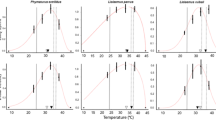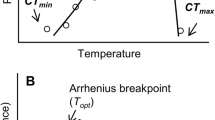Abstract
Temperate-zone ectotherms experience varying or very low ambient temperatures and may have difficulty in attaining preferred body temperatures. Thus, adaptations to reduce the thermal dependence of physiological processes may be present. We measured the optimal temperature range for sprint speed and compared it with the selected body temperatures (T sel) of two sympatric, cool-temperate lizards: the diurnal skink Oligosoma maccanni and the primarily nocturnal gecko Woodworthia (previously Hoplodactylus) “Otago/Southland”. We also investigated whether time-of-day influenced sprint speed. Contrary to results for other reptiles, we found that time-of-day did not influence speed in either species. For each species, the optimal temperature range for sprinting and T sel overlapped, supporting the ‘thermal coadaptation’ hypothesis. However, the optimal range of temperatures for speed is not always attainable during activity by either species, which have limited opportunities to attain T sel in the field. The thermal sensitivity of sprint speed in these two species does not appear to have evolved to fully match their current thermal environment. More data on cold-adapted species are needed to fully understand physiological adaptation in ectotherms.


Similar content being viewed by others
References
Angilletta MJ (2009) Thermal adaptation: a theoretical and empirical synthesis. Oxford University Press, Oxford
Angilletta MJ Jr, Werner YL (1998) Australian geckos do not display diel variation in thermoregulatory behavior. Copeia 1998:736–742
Angilletta MJ Jr, Hill T, Robson MA (2002a) Is physiological performance optimized by thermoregulatory behavior? a case study of the eastern fence lizard, Sceloporus undulatus. J Therm Biol 27:199–204
Angilletta MJ Jr, Niewiarowski PH, Navas CA (2002b) The evolution of thermal physiology in ectotherms. J Therm Biol 27:249–268
Angilletta MJ Jr, Bennett AF, Guderly H, Navas CA, Seebacher F, Wilson RS (2006) Coadaptation: a unifying principle in evolutionary thermal biology. Physiol Biochem Zool 79:282–294
Autumn K, Jindrich D, DeNardo DF, Mueller R (1999) Locomotor performance at low temperature and the evolution of nocturnality in geckos. Evolution 53:580–599
Avery RA (1982) Field studies of body temperatures and thermoregulation. In: Gans C, Pough FH (eds) Biology of the reptilia. Academic Press, London, pp 93–166
Bauwens D, Garland TJ, Castilla AM, Van Damme R (1995) Evolution of sprint speed in lacertid lizards: morphological, physiological, and behavioural covariation. Evolution 49:848–863
Ben-Ezra E, Blouin-Demers G (2008) Are locomotor performances coadapted to preferred basking temperature in the northern map turtle (Graptemys geographica)? J Herpetol 42:322–331
Bennett AF (1980) The thermal dependence of lizard behaviour. Anim Behav 28:752–762
Besson AA, Cree A (2011) Integrating physiology into conservation: an approach to help guide translocations of a rare reptile in a warming environment. Anim Conserv 14:28–37
Blouin-Demers G, Weatherhead PJ, McCracken HA (2003) A test of the thermal coadaptation hypothesis with black rat snakes (Elaphe obsoleta) and northern water snakes (Nerodia sipedon). J Therm Biol 28:331–340
Bonine KE, Garland T (1999) Sprint performance of phrynosomatid lizards, measured on a high-speed treadmill, correlates with hindlimb length. J Zool 248:255–265
Bustard HR (1967) Activity cycle thermoregulation in the Australian gecko Gehyra variegata. Copeia 1967:753–758
Cooke ES (1969) A comparison of rates of water loss by evaporation, rates of carbon dioxide expiration, and ventilation rates in two New Zealand lizards, Leiolopisma zelandica (Gray) and Hoplodactylus pacificus (Gray). Unpublished BSc honours thesis, Department of Zoology, University of Otago, Dunedin, New Zealand, p 72
Cree A, Guillette LJ Jr (1995) Biennial reproduction with a fourteen-month pregnancy in the gecko Hoplodactylus maculatus from southern New Zealand. J Herpetol 29:163–173
Cree A, Hare KM (2010) Equal thermal opportunity does not result in equal gestation length in a cool-climate skink and gecko. Herpetol Conserv Biol 5:271–282
Crossin GT, Hinch SG, Cooke SJ, Welch DW, Patterson DA, Jones SRM, Lotto AG, Leggatt RA, Mathes MT, Shrimpton JM, Van Der Kraak G, Farrell AP (2008) Exposure to high temperature influences the behaviour, physiology and survival of sockeye salmon during spawning migration. Can J Zool 86:127–140
Dorcas ME, Hopkins WA, Roe JH (2004) Effects of body mass and temperature on standard metabolic rate in the eastern diamondback rattlesnake (Crotalus adamanteus). Copeia 2004:145–151
Du W, Yan S, Ji X (2000) Selected body temperature, thermal tolerance and thermal dependence of food assimilation and locomotor performance in adult blue-tailed skinks, Eumeces elegans. J Therm Biol 25:197–202
Garland TJ, Hankins E, Huey RB (1990) Locomotor capacity and social dominance in male lizards. Funct Ecol 4:243–250
Gilchrist GW (2000) The evolution of thermal sensitivity in changing environments. In: Storey KB, Storey JM (eds) Cell and molecular response to stress: environmental stressors and gene responses. Elsevier Science, Amsterdam, pp 55–70
Grbac I, Bauwens D (2001) Constraints on temperature regulation in two sympatric Podarcis lizards during autumn. Copeia 2001:178–186
Hare JR, Holmes KM, Wilson JL, Cree A (2009) Modelling exposure to selected temperature during pregnancy: the limitations of reptilian viviparity in a cool-climate environment. Biol J Linn Soc 96:541–552
Hare KM, Pledger S, Thompson MB, Miller JH, Daugherty CH (2006) Daily patterns of metabolic rate among New Zealand lizards (Reptilia: Lacertilia: Diplodactylidae & Scincidae). Physiol Biochem Zool 79:745–753
Hare KM, Pledger S, Thompson MB, Miller JH, Daugherty CH (2007) Low cost of locomotion in lizards that are active at low temperatures. Physiol Biochem Zool 80:46–58
Hertz PE, Huey RB, Stevenson RD (1993) Evaluating temperature regulation by field-active ectotherms: the fallacy of the inappropriate question. Am Nat 142:796–818
Hitchmough RA, Hoare JM, Jamieson H, Newman DG, Tocher MD, Anderson PJ, Lettink M, Whitaker AH (2010) Conservation status of New Zealand reptiles, 2009. N Z J Zool 37:203–224
Huey RB, Bennett AF (1987) Phylogenetic studies of coadaptation: preferred temperatures versus optimal performance temperatures of lizards. Evolution 41:1098–1115
Huey RB, Kingsolver JG (1989) Evolution of thermal sensitivity of ectotherm performance. Trends Ecol Evol 4:131–135
Huey RB, Niewiarowski PH, Kaufmann J, Herron JC (1989) Thermal biology of nocturnal ectotherms: is sprint performance of geckos maximal at low body temperatures? Physiol Zool 62:488–504
Huey RB, Stevenson RD (1979) Integrating thermal physiology and ecology of ectotherms: a discussion of approaches. Am Zool 19:357–366
Husak JF, Fox SF, Lovern MB, van den Bussche RA (2006) Faster lizards sire more offspring: sexual selection on whole-animal performance. Evolution 60:2122–2130
Irschick DJ, Garland T Jr (2001) Integrating function and ecology in studies of adaptation: investigations of locomotor capacity as a model system. Ann Rev Ecol Syst 32:367–396
Lachenicht MW, Clusella-Trullas S, Boardman L, Le Roux C, Terblanche JS (2010) Effects of acclimation temperature on thermal tolerance, locomotion, performance and respiratory metabolism in Acheta domesticus L. (Orthopeta: Gryllidae). J Insect Physiol 56:822–830
Lailvaux SP, Irschick DJ (2006) A functional perspective on sexual selection: insights and future prospects. Anim Behav 72:263–273
Licht P, Dawson WR, Shoemaker VH, Main AR (1966) Observations on the thermal relations of western Australian lizards. Copeia 1966:97–110
Llewelyn J, Shine R, Webb JK (2006) Time of testing affects locomotor performance in nocturnal versus diurnal snakes. J Therm Biol 31:268–273
Miller KA, Hare KM, Nelson NJ (2010) Do alternate escape tactics provide a means of compensation for impaired performance ability? Biol J Linn Soc 99:241–249
Nielsen SV, Bauer AM, Jackman T, Hitchmough RA, Daugherty CH (2010) New Zealand geckos (Diplodactylidae): cryptic diversity in a post-Gondwanan lineage with trans-Tasman affinities. Mol Phylogenet Evol 59:1–22
R-Development-Core-Team (2008) R: A language and environment for statistical computing. R Foundation for Statistical Computing, Vienna
Rock J, Andrews RM, Cree A (2000) Effects of reproductive condition, season, and site selected temperatures of a viviparous gecko. Physiol Biochem Zool 73:344–355
Rock J, Cree A (2003) Intraspecific variation in the effect of temperature on pregnancy in the viviparous gecko Hoplodactylus maculatus. Herpetologica 59:8–22
Rock J, Cree A, Andrews RM (2002) The effect of reproductive condition on thermoregulation in a viviparous gecko from a cool climate. J Therm Biol 27:17–27
Underwood H (1992) Endogenous rhythms. In: Gans C, Crews D (eds) Biology of reptilia, vol 18. University of Chicago Press, Chicago, pp 229–297
Van Damme R, Bauwens D, Verheyen RF (1990) Evolutionary rigidity of thermal physiology: the case of the cool temperate lizard Lacerta vivipara. Oikos 57:61–67
Van Damme R, Bauwens D, Verheyen RF (1991) The thermal dependence of feeding behaviour, food consumption and gut-passage time in lizard Lacerta vivipara Jacquin. Funct Ecol 5:507–517
Van Damme R, Vanhooydonck B (2001) Origins of interspecific variation in lizard sprint capacity. Funct Ecol 15:186–202
Wagner-Smith K, Kay SA (2000) Circadian rhythm genetics: from flies to mice to humans. Nat Genet 26:23–27
Zhang Y, Ji X (2004) The thermal dependence of food assimilation and locomotor performance in southern grass lizards, Takydromus sexlineatus (Lacertidae). J Therm Biol 29:45–53
Acknowledgments
We thank our field assistants for their help in catching the lizards, and land-owners for access to their land. We also thank Amy Armstrong, Kim Garrett, Murray McKenzie and Ken Miller for their assistance in maintaining animals and/or the housing facility. We also thank members of the Cree lab for comments on manuscript drafts. This study originated as undergraduate research projects and we thank Kylie Cranston, Kate Davidson, David Elder, Matthew Gane, Michael Greer, Hadlee Lambie, Matthew Lepkowski, Yuki Maekawa, Catherine Nottingham, Kaitlyn White and Rachel Worth for their involvement. Financial support was provided by the Foundation for Research Science and Technology, New Zealand Science and Technology Postdoctoral Fellowship to KMH. Captive lizards were maintained following consultation with Ngāi Tahu and approval from the New Zealand Department of Conservation and the University of Otago Animal Ethics Committee.
Author information
Authors and Affiliations
Corresponding author
Rights and permissions
About this article
Cite this article
Gaby, M.J., Besson, A.A., Bezzina, C.N. et al. Thermal dependence of locomotor performance in two cool-temperate lizards. J Comp Physiol A 197, 869–875 (2011). https://doi.org/10.1007/s00359-011-0648-3
Received:
Revised:
Accepted:
Published:
Issue Date:
DOI: https://doi.org/10.1007/s00359-011-0648-3




